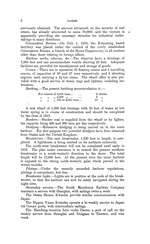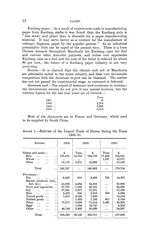| 1 |
 |
“...CONTENTS
---
Page
Maps
Kwantung leased territory.
Manchuria..
Currency ..........................................................................................3
Weights and measures ..............................................................................................................................4
Territory, extent and population of.......................................................4
General remarks...............................................................................5
Port Arthur.......................................................................................5
Loan systems .....................................................................................5
Colonisation Bureau ....................................................................................................................................6
Harbour works ....................................................................................................................................6...”
|
|
| 2 |
 |
“...4
Weights and measures.Business with the Chinese is done in catties and
piculs, and with the Japanese according to Japanese measures, a list of which is
appended. The beans come down from the interior in bags, each of which weighs
from 185 to 200 lbs. avoir. Bean cake is reckoned by the piece, the weight of
which is nearly 60 lbs. Bean oil is sold by the picul and exported in old petroleum
tins, one tin holding about 37 lbs. The South Manchuria Railway statistics are
made up in short tons (2,000 lbs.):
Chinese
1 catty
1 picuj
lli......
1 mow
Japanese
1 kin ......
1 ken (6 shaku) ...
1 ri (36 cho)
1 tsubo ......
1 koku (liquid) (10 to)
1 koku (dry)
1J lbs.
133J lbs,
J mile
736£ square yards
1-323 lbs.
5-965 feet
2-44 miles
36 square feet
39-703 gallons
4-963 bushels
Territory, extent and population of.The Consular district of Dairen comprises
the Kwantung leased territory and has an area of 1,220 square miles. The
population at the end of 1910 was about 425,000, of whom 33,600 were Japanese...”
|
|
| 3 |
 |
“...SKETCH MAP of part of MANCHURIA
Ordnance? Survey Office. Southampton., 1911....”
|
|
| 4 |
 |
“...the returns furnished by the two departments,
but there is agreement in the main facts that imports have increased
considerably, while exports have slightly declined, and that the total
trade of the port shows a small advance over 1909.
The fact that Dairen has done little more than hold its own during
the year under review goes a long way towards endorsing the opinion
that there is ample room for the two ports of Newchwang and Dairen
as ports of entry for goods destined for the markets of Manchuria.
The nature of the bulk of the business at Newchwang differs greatly
from that at this port and the system of commercial exchange is on
a different basis. The natural superiority of Dairen consists in its
freedom from ice, whereas Newchwang is closed for some months
during the winter. This is, of course, an important factor in the
situation, particularly as the closure coincides with the busy export
season ; but there is a factor of equal importance militating in favour
of Newchwang, viz., the...”
|
|
| 5 |
 |
“...present northern
breakwater in a south-westerly direction to the shore. The total
length will be 12,000 feet. At the present time the inner harbour
is exposed to the strong north-westerly gales which prevail in the
winter months.
Pilotage.Under the recently amended harbour regulations,
pilotage is compulsory, but free.
Breakwater lights.Lights are in position at the ends of the break-
waters, so that the harbour can now be safely navigated during the
night time.
Steamship services.The South Manchuria Railway Company
maintain a service with Shanghai, with sailings twice a week.
The Osaka Shosen Kwaisha provide similar communication with
Japan.
The Nippon Yusen Kwaisha operate a bi-weekly service to Japan
via Corean ports, with intermediate sailings.
The Hamburg-America Line make Dairen a port of call on the
weekly service from Shanghai and Tsingtau to Tientsin, and vice
versa....”
|
|
| 6 |
 |
“...dairen.
7
The South Manchuria Railway Company have ordered two new
steamers, one of 1,000 tons from Osaka and one of 1,300 tons from
Hong-Kong, for use between Antung, Dairen, Chefoo and Tientsin.
The Indo-China Steam Navigation Company and the China
Navigation Company now maintain a weekly service between Shanghai
and Dairen, calling at Newchwang on the outward journey.
Gas.The condition of the gasworks undertaking appears to be
promising. The number of customers is now nearly 3,000 and the
daily consumption about 100,000 cubic feet. The plans for 1911
include an extension of 3 miles of pipes.
Electric lighting.The demand for electricity has increased from
3,310,000 kilowatts in 1909 to 6,020,000 kilowatts in 1910, and the
number of lights from 16,000 to 27,000.
This year's demand for power is thirty times as great as that for 1909
the demand in 1910 was 115,975 kilowattschiefly owing to the
expansion of the small bean mill industry, under Chinese capital.
In the Dairen power station four...”
|
|
| 7 |
 |
“...1909-10 season ... 1910-11 season j Tons. 268,480 ... 175,354 Tons. 72,480 181,893 Tons. 340,960 357,247
An examination of the above figures will show that the recent
epidemic of pneumonic plague has exercised little, if any, effect on
the bean trade of the present season. It is in the coming season,
and possibly two seasons, that the real influence will be felt. It is
already time for preparing the land for next season's crop ; labour
is scarce and the quarantine restrictions in Shantung and Manchuria
will undoubtedly result in a large reduction of coolie immigration
at a time when it is most urgently needed.
One-half of the shipments of beans during the year 1910 were to
Port Said to await orders, and over a quarter went to Japan, whence
a considerable amount was transhipped to European markets.
The following remarks on bean oil and bean cake are contributed :
Bean oil.Exports to the United Kingdom, the Continent and
the United States of America had not assumed any great proportions
at the...”
|
|
| 8 |
 |
“...comprised the new season's beans,
the quantity shipped was some 63,000 tons.
The cakes are all made to a uniform weight of 46 kin, but are in
two kinds, one with rims and the other plain, the former being a sen
or two dearer.
Prices varied considerably during 1910, the year commencing
with more or less original prices round about 1 yen (silver) per
cake, while when the new season's crop came along cakes went to
1 yen 18 sen (silver) to 1 yen 25 sen (silver) per piece.
Silk.A department of the South Manchuria Railway Company
commenced operations in the silk spinning industry on the lines given
in last year's report of the trade of this district, but the filature was
obliged to suspend work in November. It appears that the Japanese
hands employed in this establishment were inferior; they were,
perforce, all imported from Japan proper, and the wages payable here,
compatible with a possible business profit, were not high enough to
secure the services of really skilled labour.
From the opening of the...”
|
|
| 9 |
 |
“...Kaoliang stalks it was found that the Kaoliang pulp is
" less sticky and pliant than is desirable for a paper manufacturing
material. It may serve better as a mixture for the manufacture of
ordinary Japanese paper by the popular process." As an industrial
potentiality little can be urged at the present time. There is a keen
Chinese demand throughout Manchuria for Kaoliang cane for fuel
and various other domestic purposes, and unless coal supersedes
Kaoliang cane as a fuel and the cost of the latter is reduced by about
60 per cent., the future of a Kaoliang paper industry is not very
promising.
Raisins.It is claimed that the climate and soil of Manchuria
are admirably suited to the raisin industry, and that very favourable
competition with the American import can be obtained. The matter
has not yet passed the experimental stage, so comment is deferred.
Sesamnm seed.The export of sesamum seed continues to increase;
the Government returns do not give it any special mention, but the
customs figures...”
|
|